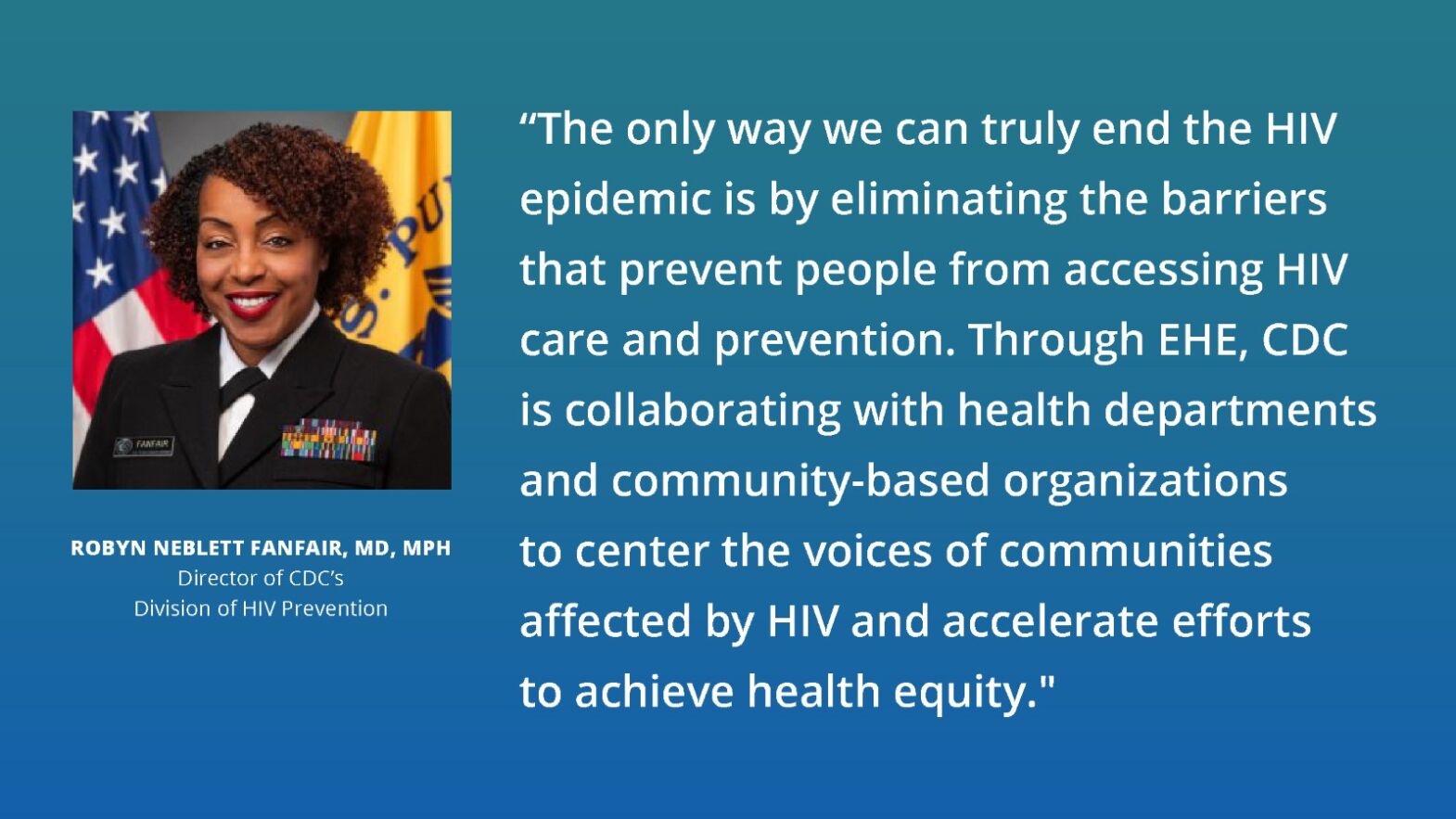At a glance
- Ending the HIV Epidemic in the US (EHE) is an initiative coordinated by the US Department of Health and Human Services (HHS).
- EHE increases the nation’s investment in proven HIV prevention tools and technologies and programs.

Ending the HIV epidemic in the US by 2030
EHE's goals include:
- Reducing new HIV infections in the United States by 75% by 2025 and by 90% by 2030
- Advancing health equity by scaling up key HIV prevention and treatment strategies
Through EHE, CDC is working with partners to accelerate progress toward HIV prevention goals. CDC does this by advancing solutions to address social and structural barriers to prevention and care.
Approach
EHE ensures they reach the communities and populations most affected by HIV. EHE also complements the National HIV/AIDS Strategy, which provides a roadmap for a whole-of-society response to ending the HIV epidemic.
EHE is rooted in equity and focused on implementing community-specific strategies.
CDC's role in the Ending the HIV Epidemic in the US initiative
CDC gives local leaders the flexibility to design and implement prevention strategies tailored to the specific needs of their communities.
With support from CDC, EHE jurisdictions develop local implementation plans. These plans detail forward-thinking strategies to meet the needs of communities, address social determinants of health, and advance health equity. CDC also supports jurisdictions in implementing whole-person approaches that dismantle HIV-related stigma and other barriers to care.

Community involvement
As a whole-of-society initiative, EHE is by its nature a community-focused health equity intervention. For EHE to be successful, HIV interventions must reach the people and communities who would benefit. CDC EHE Partnerships include:
- Academic Institutions
- Civic Organizations
- Community-Based Organizations (CBOs)
- Faith-Based Organizations
- Federal Agencies and Offices
- Housing Organizations
- Mental Health Organizations
- Non-Profit Organizations
- People with HIV
- People Who Can Benefit from HIV Prevention
- Private Sector
- Rural Communities
- State and Local Health Departments
- STI and Substance Use Clinics
- Other HIV-Focused Collaborators
Community is at the heart of EHE and CBOs play a critical role in providing HIV services to people who need them. CDC listens to people with and affected by HIV and integrates their needs and ideas into EHE strategies. This includes the development and implementation of novel, culturally responsive, and equity-focused HIV prevention strategies, programs, research, and other initiatives.
EHE jurisdictions must allocate at least 25% of their EHE funding for planning and implementation of EHE activities by CBOs. In addition to HIV prevention programs, example activities include:
- Housing and employment support
- Mental health services
- Substance use disorder treatment
- Comprehensive sexual health services
CDC’s process for increasing community involvement and engagement
- Consistently engaging with the community to understand community needs and inform EHE and other activities.
- Building partnerships and strengthening collaborations with diverse partners to identify and implement equity-focused strategies.
- Funding health departments and CBOs to design and implement equity-focused HIV prevention and other interventions tailored for their communities.
- Providing capacity building and technical assistance to organizations to sustain HIV, health, and other social services infrastructure in their communities.
- Developing guidance on best practices for effective community engagement that is shared with EHE-funded jurisdictions and other CDC partners.
HIV and whole-person care
A whole-person approach to HIV prevention and treatment considers the multitude of factors affecting a person's health. The approach addresses healthcare and social service needs to engage and retain people in HIV treatment or prevention services. Whole-person care benefits people with HIV and people who can benefit from prevention. This approach helps overcome structural and social barriers to care, eliminate stigma, and improve people's health.
With whole-person care, CDC's HIV prevention programs can build or expand flexible and tailored interventions. CDC continually conducts implementation science and collaborates with partners to improve whole-person approaches to HIV prevention and treatment.
Whole-person care approaches can include:
News and Updates
Who made this possible
EHE is a collaboration among HHS agencies and offices working together to meet national HIV prevention goals.
Participating agencies and offices include:
Milestones
Since EHE was announced in February 2019, CDC and its partners have reached several important milestones, including regularly releasing crucial funding to health departments and community-based organizations to build local capacity and scale up proven strategies.
Visit HIV.gov for important EHE updates.
